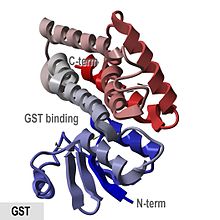
Back جلوتاثيون أس-ترانسفيراز Arabic Glutathion-S-transferáza Czech Glutathion-S-Transferasen German Glutation-S-transferaso Esperanto Glutatión S-transferasa Spanish Glutationi-S-transferaasi Finnish Glutathion S-transférase French Glutation S-transferase ID グルタチオン-S-トランスフェラーゼ Japanese Glutation transferaza Serbo-Croatian
This article may be too technical for most readers to understand. (February 2021) |
| Glutathione S-transferase | |||||||||
|---|---|---|---|---|---|---|---|---|---|
 Crystallographic structure of glutathione S-transferase from Anopheles cracens.[1] | |||||||||
| Identifiers | |||||||||
| EC no. | 2.5.1.18 | ||||||||
| CAS no. | 50812-37-8 | ||||||||
| Databases | |||||||||
| IntEnz | IntEnz view | ||||||||
| BRENDA | BRENDA entry | ||||||||
| ExPASy | NiceZyme view | ||||||||
| KEGG | KEGG entry | ||||||||
| MetaCyc | metabolic pathway | ||||||||
| PRIAM | profile | ||||||||
| PDB structures | RCSB PDB PDBe PDBsum | ||||||||
| Gene Ontology | AmiGO / QuickGO | ||||||||
| |||||||||
Glutathione S-transferases (GSTs), previously known as ligandins, are a family of eukaryotic and prokaryotic phase II metabolic isozymes best known for their ability to catalyze the conjugation of the reduced form of glutathione (GSH) to xenobiotic substrates for the purpose of detoxification. The GST family consists of three superfamilies: the cytosolic, mitochondrial, and microsomal—also known as MAPEG—proteins.[1][2][3] Members of the GST superfamily are extremely diverse in amino acid sequence, and a large fraction of the sequences deposited in public databases are of unknown function.[4] The Enzyme Function Initiative (EFI) is using GSTs as a model superfamily to identify new GST functions.
GSTs can constitute up to 10% of cytosolic protein in some mammalian organs.[5][6] GSTs catalyse the conjugation of GSH—via a sulfhydryl group—to electrophilic centers on a wide variety of substrates in order to make the compounds more water-soluble.[7][8] This activity detoxifies endogenous compounds such as peroxidised lipids and enables the breakdown of xenobiotics. GSTs may also bind toxins and function as transport proteins, which gave rise to the early term for GSTs, ligandin.[9][10]
- ^ a b PDB: 1R5A; Udomsinprasert R, Pongjaroenkit S, Wongsantichon J, Oakley AJ, Prapanthadara LA, Wilce MC, Ketterman AJ (June 2005). "Identification, characterization and structure of a new Delta class glutathione transferase isoenzyme". The Biochemical Journal. 388 (Pt 3): 763–71. doi:10.1042/BJ20042015. PMC 1183455. PMID 15717864.
- ^ Sheehan D, Meade G, Foley VM, Dowd CA (November 2001). "Structure, function and evolution of glutathione transferases: implications for classification of non-mammalian members of an ancient enzyme superfamily". The Biochemical Journal. 360 (Pt 1): 1–16. doi:10.1042/0264-6021:3600001. PMC 1222196. PMID 11695986.
- ^ Allocati N, Federici L, Masulli M, Di Ilio C (January 2009). "Glutathione transferases in bacteria". The FEBS Journal. 276 (1): 58–75. doi:10.1111/j.1742-4658.2008.06743.x. PMID 19016852.
- ^ Cite error: The named reference
pmid19842715was invoked but never defined (see the help page). - ^ Boyer TD (March 1989). "The glutathione S-transferases: an update". Hepatology. 9 (3): 486–96. doi:10.1002/hep.1840090324. PMID 2646197. S2CID 85179401.
- ^ Mukanganyama S, Bezabih M, Robert M, Ngadjui BT, Kapche GF, Ngandeu F, Abegaz B (August 2011). "The evaluation of novel natural products as inhibitors of human glutathione transferase P1-1". Journal of Enzyme Inhibition and Medicinal Chemistry. 26 (4): 460–7. doi:10.3109/14756366.2010.526769. PMID 21028940. S2CID 41391243.
- ^ Douglas KT (1987). "Mechanism of action of glutathione-dependent enzymes". Advances in Enzymology and Related Areas of Molecular Biology. Vol. 59. pp. 103–67. doi:10.1002/9780470123058.ch3. ISBN 9780470123058. PMID 2880477.
- ^ Cite error: The named reference
pmid21428697was invoked but never defined (see the help page). - ^ Leaver MJ, George SG (1998). "A piscine glutathione S-transferase which efficiently conjugates the end-products of lipid peroxidation". Marine Environmental Research. 46 (1–5): 71–74. Bibcode:1998MarER..46...71L. doi:10.1016/S0141-1136(97)00071-8.
- ^ Litwack G, Ketterer B, Arias IM (December 1971). "Ligandin: a hepatic protein which binds steroids, bilirubin, carcinogens and a number of exogenous organic anions". Nature. 234 (5330): 466–7. Bibcode:1971Natur.234..466L. doi:10.1038/234466a0. PMID 4944188. S2CID 4216672.
© MMXXIII Rich X Search. We shall prevail. All rights reserved. Rich X Search